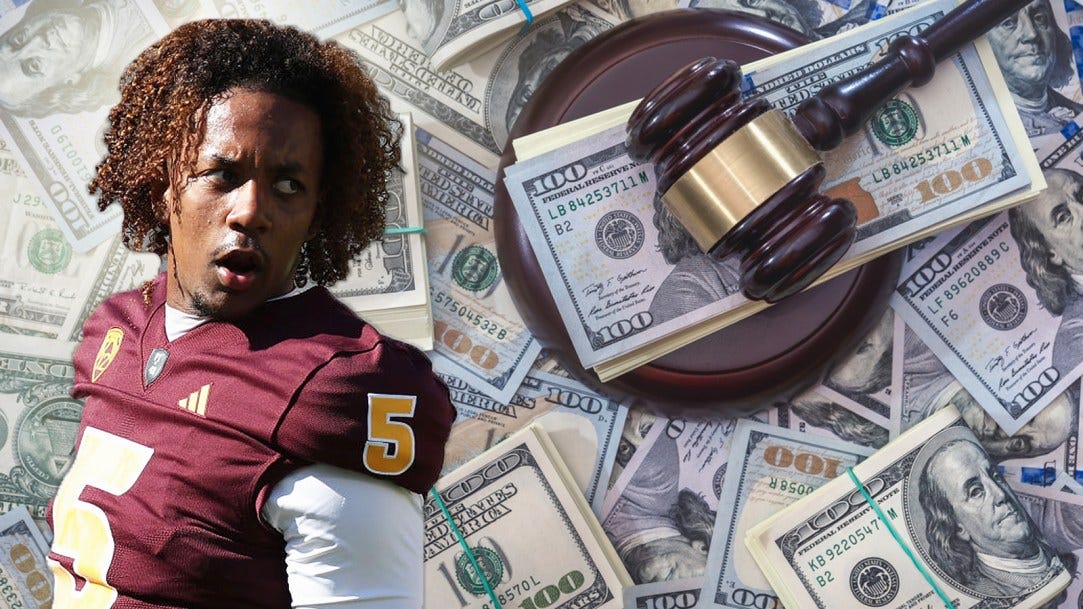Friday Feature: Promises, Paper Trails, and Paydays
The Legal Takeways from the Latest NIL Drama
Introduction
Name, Image, and Likeness (NIL) has been dominating the college sports landscape, especially with the House settlement, the ever-churning transfer portal, and the headline-grabbing NIL deals student-athletes are signing. Just when it seemed the dust might settle, another wave of legal drama hits—this time spanning from Florida to Arkansas. The broken promises behind high-dollar NIL commitments are keeping sports law professionals—and compliance officers—busier than ever.
As conversations around “pay-for-play” intensify, universities, athletic directors, newly minted general managers, and the athletes themselves are being forced to reckon with the legal implications of NIL agreements that fall apart. The amateur model is giving way to a contract-driven system—and it’s not going quietly.
Amateur Athletics Meets Contract Law
With a revenue-sharing model on the horizon, college programs are being pushed to rethink how they allocate resources and approach the increasingly professionalized model of college sports. The era of purely amateur athletics is behind us. One of the most significant ripple effects of the NIL era? Recruiting has gotten exponentially more complicated.
Today’s top recruits aren’t just looking for tradition, facilities, or coaching staff—they’re also evaluating the bottom line. In this new landscape, players hold substantial leverage. If the offer isn’t right, there’s always the transfer portal or a decommitment post waiting. But what happens when the offers themselves are legally questionable? The Jayden Rashada lawsuit may provide a preview.
From a legal standpoint, NIL deals are increasingly governed by contract formation, reliance, and inducement principles. When verbal promises or loosely documented agreements are used to sway recruits, schools and collectives risk exposure to claims like fraudulent misrepresentation or tortious interference. The absence of written terms undermines enforceability and increases the likelihood of disputes rooted in unmet expectations or ambiguous obligations.
Jayden Rashada v. Florida: A Sign of Things to Come?
The long-brewing legal battle surrounding quarterback Jayden Rashada’s commitment saga now has a trial date: July 20, 2026. Rashada, once a Miami Hurricanes commit, flipped to Florida following a lucrative NIL deal reportedly worth $13.85 million—only for the Gators’ collective to walk away. The lawsuit, filed in May 2024, alleges that Florida head coach Billy Napier promised a $1 million payment upon signing, which never materialized. When the deal fell apart, Rashada requested his release and ultimately signed with Arizona State.
The lawsuit names Coach Napier and booster Hugh Hathcock and includes a laundry list of claims: fraudulent misrepresentation and inducement, aiding and abetting fraud, civil conspiracy, negligent misrepresentation, tortious interference with a business relationship, and more. A recent amendment even added a count for civil conspiracy to coerce. Notably absent? A breach of contract claim—likely because no formal agreement was ever signed.
Now, Rashada has entered the transfer portal once again. After a season at Arizona State and a short-lived transfer to Georgia, he’s seeking a new team while juggling a major lawsuit. And while his case took nearly two years to hit the courts, it's likely not the last of its kind.
The Next NIL Legal Showdown? Enter: The Iamaleava Brothers
Just as the Rashada case picks up steam, another NIL dispute may be looming—this time involving quarterback brothers Nico and Madden Iamaleava. With Nico’s controversial NIL deal at Tennessee paused amid scrutiny and his recent commitment to UCLA, attention has shifted to his younger brother, Madden.
Reports indicate Arkansas collectives have sent a demand letter regarding possible inducement violations connected to Madden’s recruitment. While no lawsuit has been filed yet, this move suggests that collectives are becoming more aggressive—and protective—when it comes to NIL dealings and perceived tampering.
What’s Next?
These developments are painting a clear picture: NIL is no longer just a marketing game—it’s a legal one. From fraud claims to contract law to potential NCAA violations, we’re witnessing the collision of big money and untested legal frameworks.
For athletes, programs, and collectives alike, the message is clear: document everything, lawyer up, and be ready—because the NIL era is just getting started, and the courtroom may soon be just as important as the end zone.
As we observe how the legal game will continue to shake out with NIL considerations, some expectations to be pondered include how standardized NIL contracts will be defined to adhere to compliance and enforcement provisions. While many professional athletic organizations have complex contract structures, a number of them are rooted in templated or historical practice. Presumably, collegiate general managers will begin to exploit loopholes in the NCAA’s enforcement provisions to benefit their university’s cap structure. Moreover, expect continued litigation problems over broken promises. Things can get messy, which is why institutions, collectives, and athletes must evolve together. The programs that implement strong legal frameworks, proactive oversight, and contract discipline will be best positioned for the NIL era. Everyone else may find themselves not just outbid, but outlitigated.






